Abstract
1. Strips of longitudinal muscle from guinea-pig ileum, retaining Auerbach's plexus, were superfused with oxygenated Krebs solution. Addition of 50 mM KCl led to a pronounced Ca2+-dependent increase in the activities of both acetylcholinesterase and non-specific cholinesterase (butyrylcholinesterase) in the perfusate but with no change in lactate dehydrogenase activity. 2. No release of acetylcholinesterase, either spontaneous or K+-evoked was observed in tissue freed of the nerve plexus, although release of butyrylcholinesterase still occurred. 3. Carbachol induced a marked Ca2+-dependent increase in the release of acetylcholinesterase but had no effect on the release of butyrylcholinesterase or lactate dehydrogenase. This carbachol-evoked increase in acetylcholinesterase release was blocked by hexamethonium but not by atropine. 4. Four readily soluble molecular forms of acetylcholinesterase and three soluble molecular forms of butyrylcholinesterase were present in innervated longitudinal muscle strips, but insignificant amounts of acetylcholinesterase were detected in denervated strips of muscle. Only one of the four molecular forms of acetylcholinesterase was recovered in the perfusates. 5. It is concluded that acetylcholinesterase is secreted from the nerves of Auerbach's plexus in response to depolarizing stimuli or to nicotinic cholinergic stimulation, while butyrylcholinesterase is secreted from non-neural elements, possibly the longitudinal muscle cells, of guinea-pig ileum in response to a depolarizing stimulus.
Full text
PDF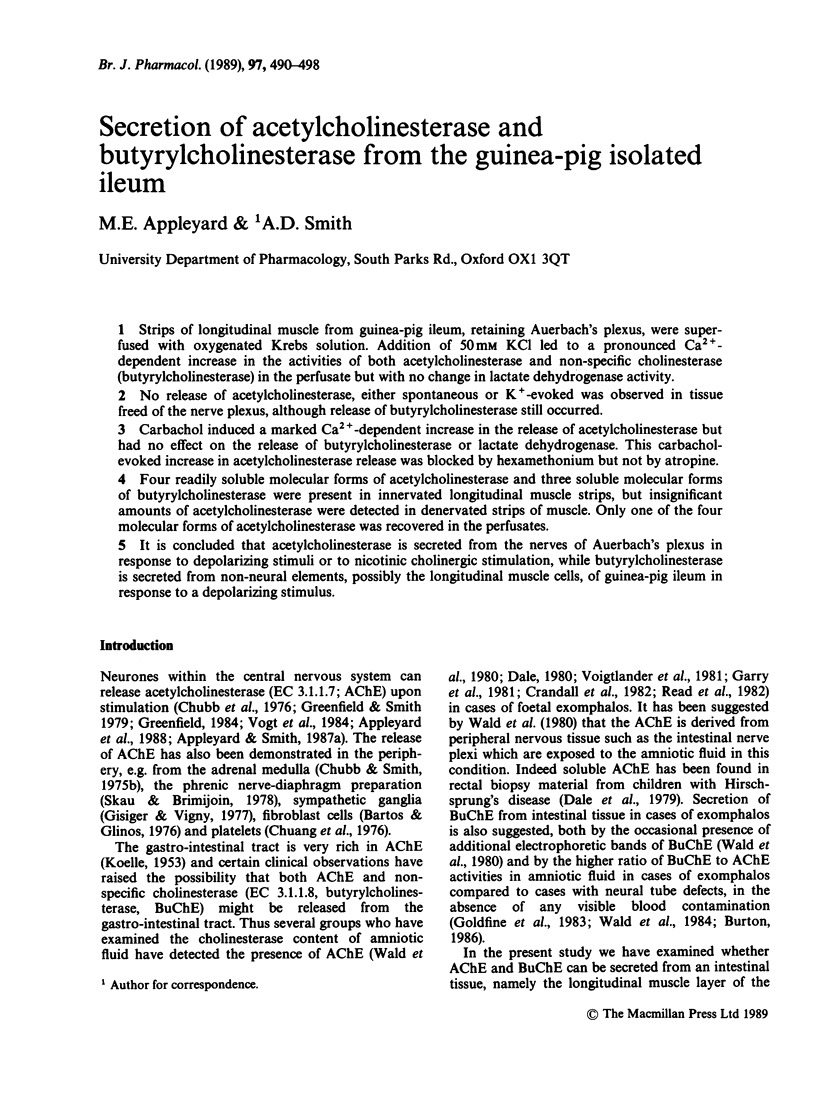

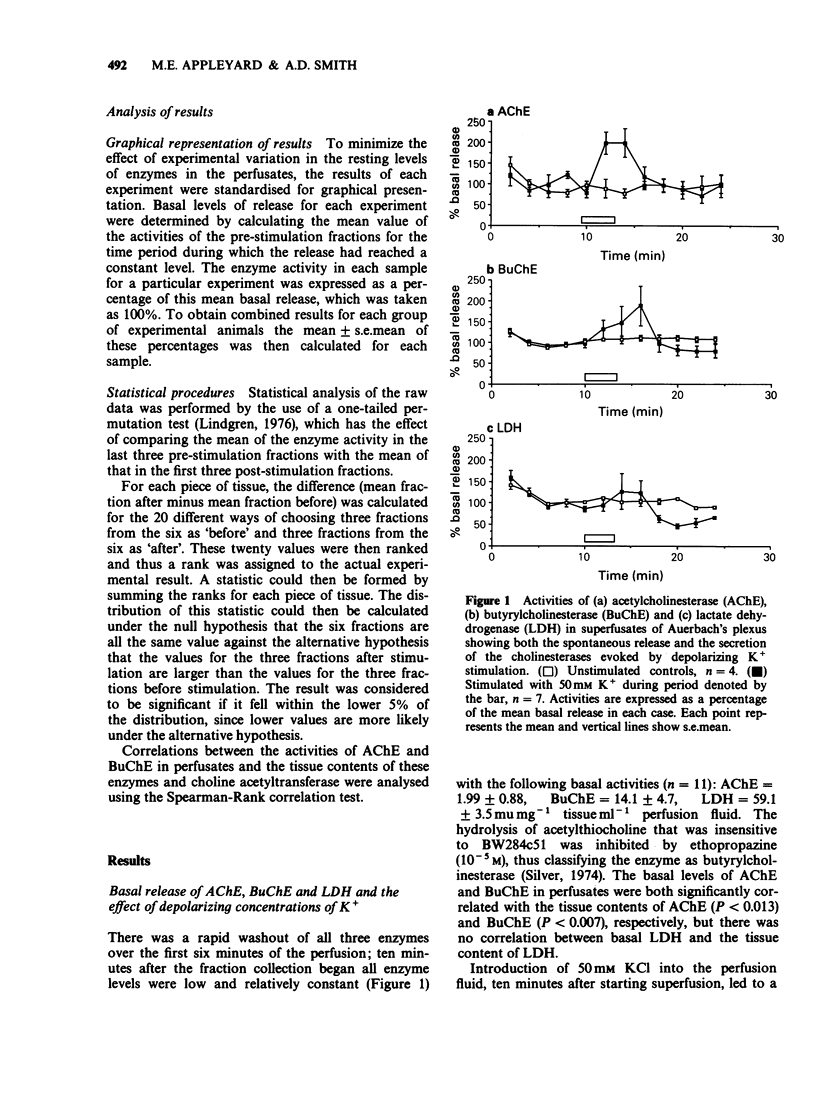
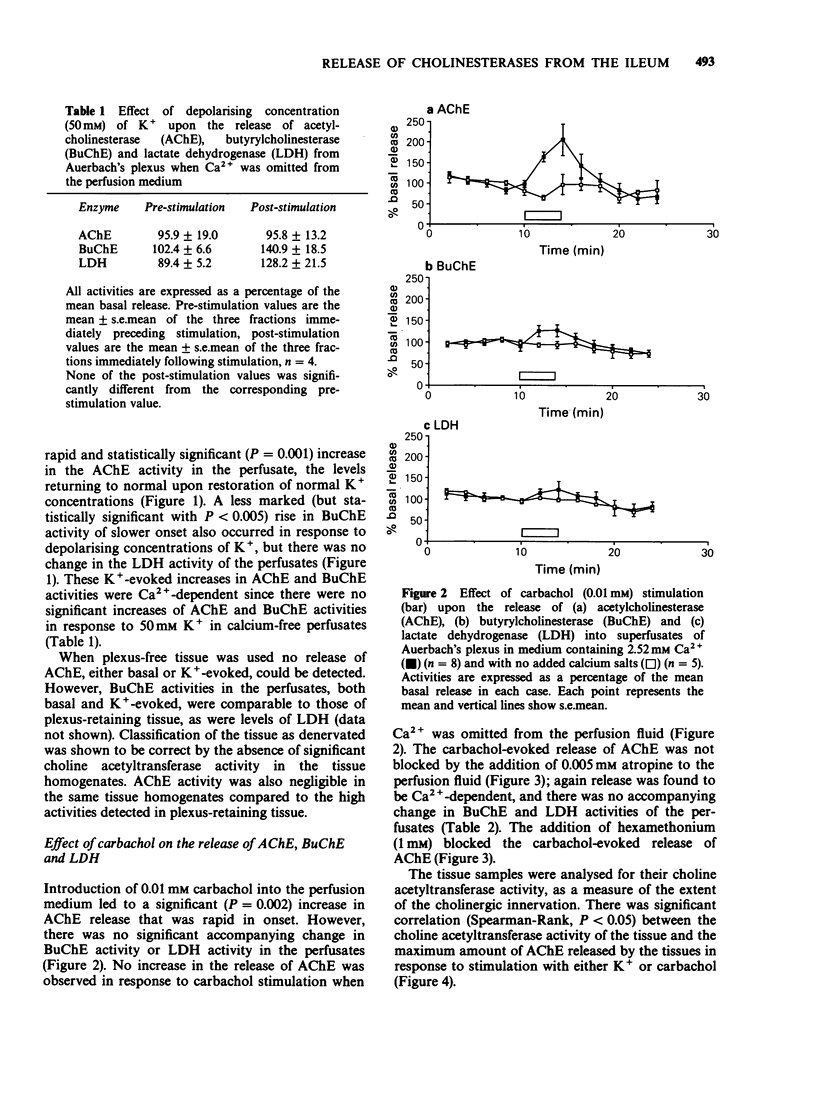
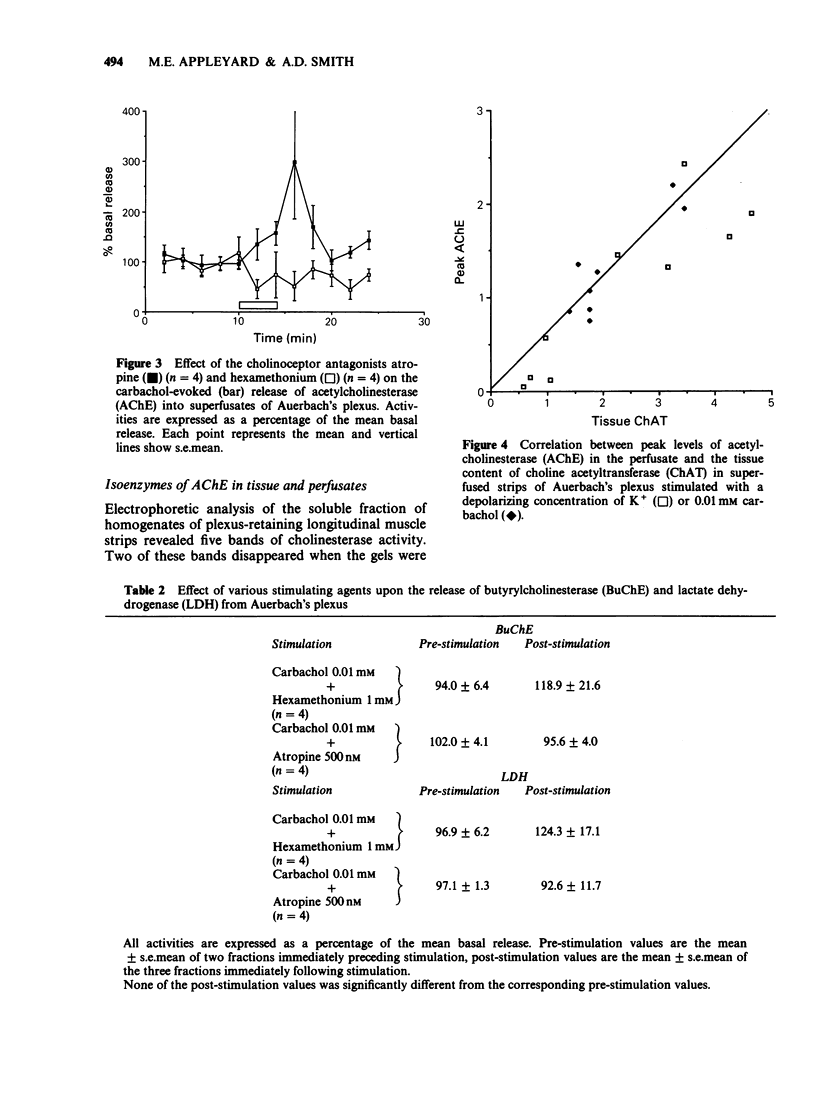
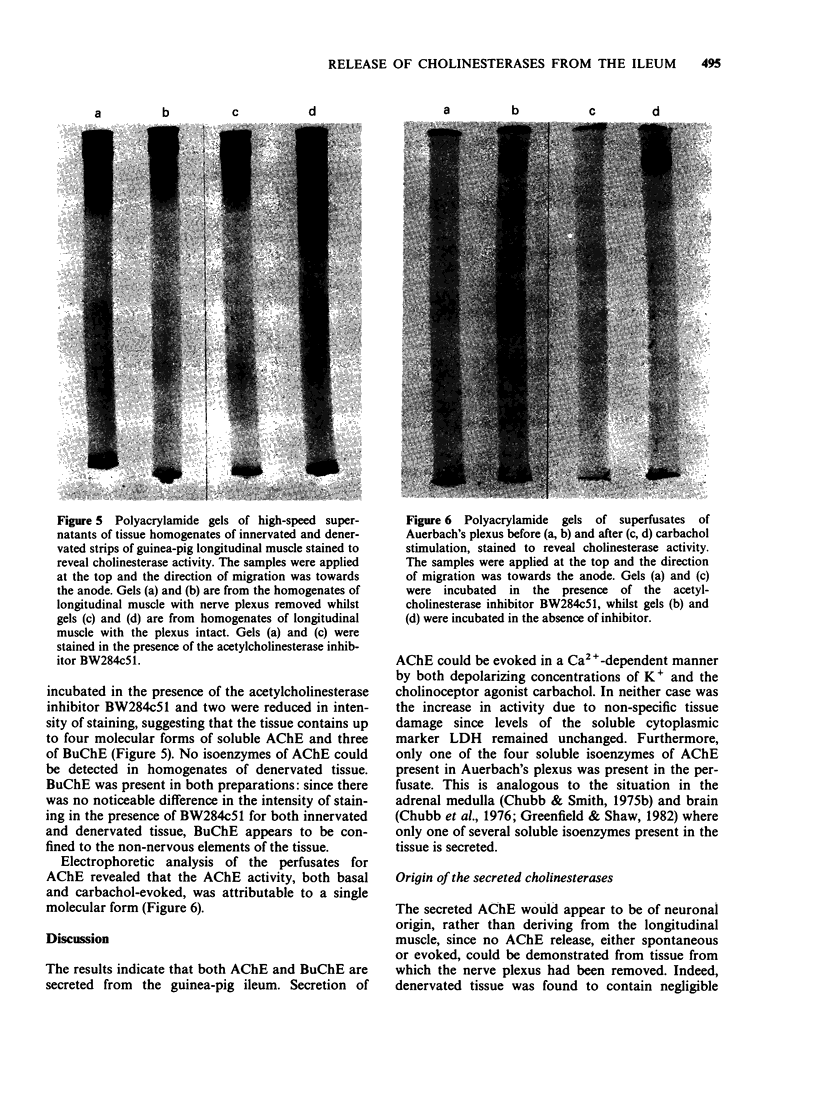
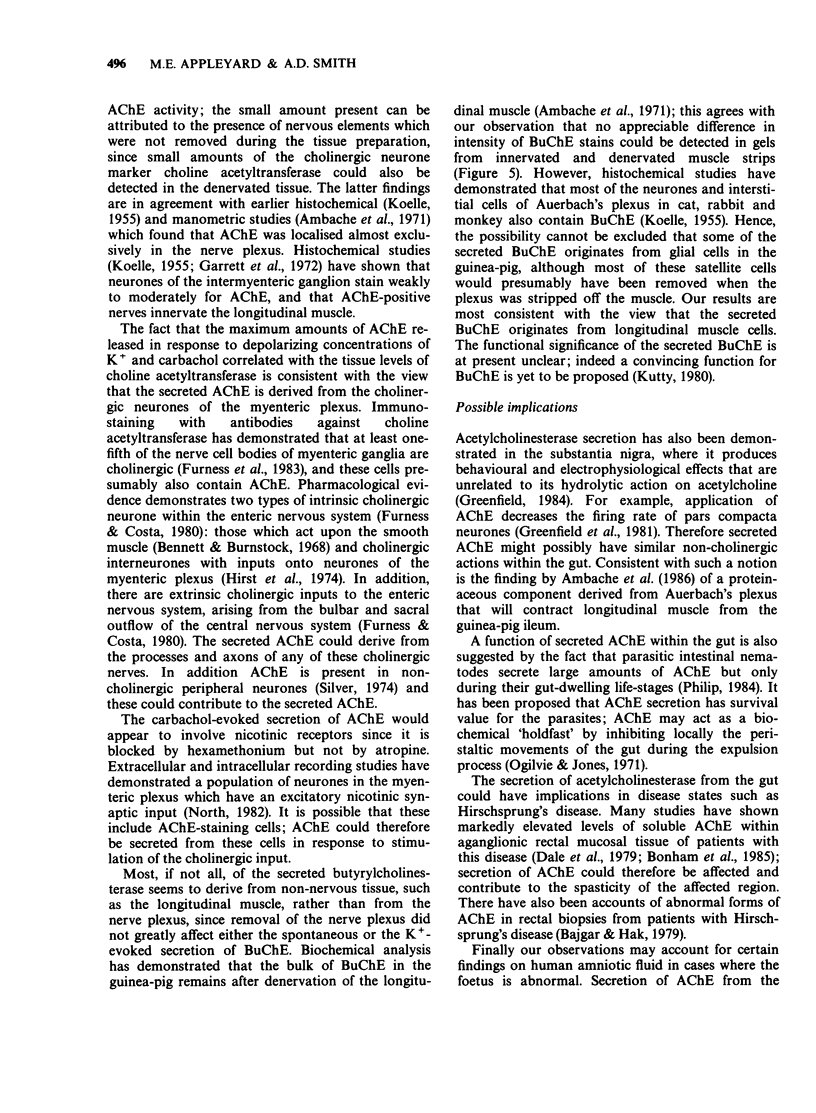
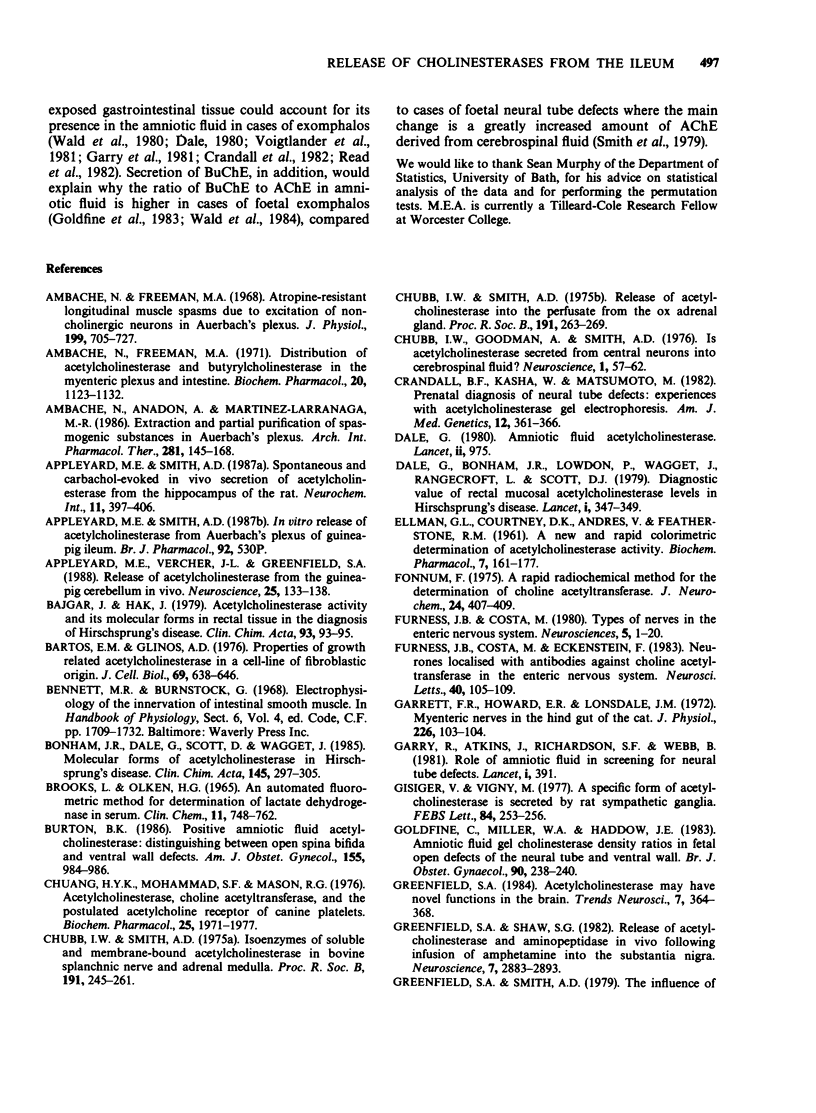

Images in this article
Selected References
These references are in PubMed. This may not be the complete list of references from this article.
- Ambache N., Anadón A., Martinez-Larrañaga M. R. Extraction and partial purification of spasmogenic substances in Auerbach's plexus. Arch Int Pharmacodyn Ther. 1986 May;281(1):145–168. [PubMed] [Google Scholar]
- Ambache N., Freeman M. A. Atropine-resistant longitudinal muscle spasms due to excitation of non-cholinergic neurones in Auerbach's plexus. J Physiol. 1968 Dec;199(3):705–727. doi: 10.1113/jphysiol.1968.sp008674. [DOI] [PMC free article] [PubMed] [Google Scholar]
- Ambache N., Freeman M. A., Hobbiger F. Distribution of acetylcholinesterase and butyrylcholinesterase in the myenteric plexus and longitudinal muscle of the guinea-pig intestine. Biochem Pharmacol. 1971 Jun;20(6):1123–1132. doi: 10.1016/0006-2952(71)90342-x. [DOI] [PubMed] [Google Scholar]
- Appleyard M. E., Vercher J. L., Greenfield S. A. Release of acetylcholinesterase from the guinea-pig cerebellum in vivo. Neuroscience. 1988 Apr;25(1):133–138. doi: 10.1016/0306-4522(88)90012-7. [DOI] [PubMed] [Google Scholar]
- BROOKS L., OLKEN H. G. AN AUTOMATED FLUOROMETRIC METHOD FOR DETERMINATION OF LACTIC DEHYDROGENASE IN SERUM. Clin Chem. 1965 Aug;11:748–762. [PubMed] [Google Scholar]
- Bajgar J., Hak J. Acetylcholinesterase activity and its molecular forms in rectal tissue in the diagnosis of Hirsprung's disease. Clin Chim Acta. 1979 Apr 2;93(1):93–95. doi: 10.1016/0009-8981(79)90248-1. [DOI] [PubMed] [Google Scholar]
- Bartos E. M., Glinos A. D. Properties of growth-related acetylcholinesterase in a cell line of fibroblastic origin. J Cell Biol. 1976 Jun;69(3):638–646. doi: 10.1083/jcb.69.3.638. [DOI] [PMC free article] [PubMed] [Google Scholar]
- Bonham J. R., Dale G., Scott D., Wagget J. Molecular forms of acetylcholinesterase in Hirschsprung's disease. Clin Chim Acta. 1985 Feb 15;145(3):297–305. doi: 10.1016/0009-8981(85)90037-3. [DOI] [PubMed] [Google Scholar]
- Burton B. K. Positive amniotic fluid acetylcholinesterase: distinguishing between open spina bifida and ventral wall defects. Am J Obstet Gynecol. 1986 Nov;155(5):984–986. doi: 10.1016/0002-9378(86)90330-3. [DOI] [PubMed] [Google Scholar]
- Chuang H. Y., Mahammad S. F., Mason R. G. Acetylcholinesterase, choline acetyltransferase, and the postulated acetylcholine receptor of canine platelets. Biochem Pharmacol. 1976 Sep 1;25(17):1971–1977. doi: 10.1016/0006-2952(76)90052-6. [DOI] [PubMed] [Google Scholar]
- Chubb I. W., Goodman S., Smith A. D. Is acetylcholinesterase secreted from central neurons into the cerebral fluid? Neuroscience. 1976;1(1):57–62. doi: 10.1016/0306-4522(76)90048-8. [DOI] [PubMed] [Google Scholar]
- Chubb I. W., Smith tad Release of acetylcholinesterase into the perfusate from the ox adrenal gland. Proc R Soc Lond B Biol Sci. 1975 Nov 18;191(1103):263–269. doi: 10.1098/rspb.1975.0127. [DOI] [PubMed] [Google Scholar]
- Chubb I. W., Smith A. D. Isoenzymes of soluble and membrane-bound acetylcholinesterase in boine splanchnic nerve and adrenal medulla. Proc R Soc Lond B Biol Sci. 1975 Nov 18;191(1103):245–261. doi: 10.1098/rspb.1975.0126. [DOI] [PubMed] [Google Scholar]
- Crandall B. F., Kasha W., Matsumoto M. Prenatal diagnosis of neural tube defects: experiences with acetylcholinesterase gel electrophoresis. Am J Med Genet. 1982 Jul;12(3):361–366. doi: 10.1002/ajmg.1320120314. [DOI] [PubMed] [Google Scholar]
- Dale G. Amniotic fluid acetylcholinesterase. Lancet. 1980 Nov 1;2(8201):975–975. doi: 10.1016/s0140-6736(80)92129-7. [DOI] [PubMed] [Google Scholar]
- Dale G., Bonham J. R., Lowdon P., Wagget J., Rangecroft L., Scott D. J. Diagnostic value of rectal mucosal acetylcholinesterase levels in Hirschsprung's disease. Lancet. 1979 Feb 17;1(8112):347–349. doi: 10.1016/s0140-6736(79)92890-3. [DOI] [PubMed] [Google Scholar]
- Fonnum F. A rapid radiochemical method for the determination of choline acetyltransferase. J Neurochem. 1975 Feb;24(2):407–409. doi: 10.1111/j.1471-4159.1975.tb11895.x. [DOI] [PubMed] [Google Scholar]
- Furness J. B., Costa M., Eckenstein F. Neurones localized with antibodies against choline acetyltransferase in the enteric nervous system. Neurosci Lett. 1983 Sep 30;40(2):105–109. doi: 10.1016/0304-3940(83)90287-2. [DOI] [PubMed] [Google Scholar]
- Furness J. B., Costa M. Types of nerves in the enteric nervous system. Neuroscience. 1980;5(1):1–20. doi: 10.1016/0306-4522(80)90067-6. [DOI] [PubMed] [Google Scholar]
- Garry R., Atkins J., Richardson S. J., Webb B. Role of amniotic fluid acetylcholinesterase in screening for neural tube defects. Lancet. 1981 Feb 14;1(8216):391–391. doi: 10.1016/s0140-6736(81)91716-5. [DOI] [PubMed] [Google Scholar]
- Gisiger V. A specific form of acetylcholinesterase is secreted by rat sympathetic ganglia. FEBS Lett. 1977 Dec 15;84(2):253–256. doi: 10.1016/0014-5793(77)80700-x. [DOI] [PubMed] [Google Scholar]
- Goldfine C., Miller W. A., Haddow J. E. Amniotic fluid gel cholinesterase density ratios in fetal open defects of the neural tube and ventral wall. Br J Obstet Gynaecol. 1983 Mar;90(3):238–240. doi: 10.1111/j.1471-0528.1983.tb08616.x. [DOI] [PubMed] [Google Scholar]
- Greenfield S. A., Shaw S. G. Release of acetylcholinesterase and aminopeptidase in vivo following infusion of amphetamine into the substantia nigra. Neuroscience. 1982;7(11):2883–2893. doi: 10.1016/0306-4522(82)90111-7. [DOI] [PubMed] [Google Scholar]
- Greenfield S. A., Smith A. D. The influence of electrical stimulation of certain brain regions on the concentration of acetylcholinesterase in rabbit cerebrospinal fluid. Brain Res. 1979 Nov 30;177(3):445–459. doi: 10.1016/0006-8993(79)90463-3. [DOI] [PubMed] [Google Scholar]
- Greenfield S. A., Stein J. F., Hodgson A. J., Chubb I. W. Depression of nigral pars compacta cell discharge by exogenous acetylcholinesterase. Neuroscience. 1981;6(11):2287–2295. doi: 10.1016/0306-4522(81)90018-x. [DOI] [PubMed] [Google Scholar]
- Hirst G. D., Holman M. E., Spence I. Two types of neurones in the myenteric plexus of duodenum in the guinea-pig. J Physiol. 1974 Jan;236(2):303–326. doi: 10.1113/jphysiol.1974.sp010436. [DOI] [PMC free article] [PubMed] [Google Scholar]
- KOELLE G. B. Cholinesterases of the tissues and sera of rabbits. Biochem J. 1953 Jan;53(2):217–226. doi: 10.1042/bj0530217. [DOI] [PMC free article] [PubMed] [Google Scholar]
- KOELLE G. B. The histochemical identification of acetylcholinesterase in cholinergic, adrenergic and sensory neurons. J Pharmacol Exp Ther. 1955 Jun;114(2):167–184. [PubMed] [Google Scholar]
- Kutty K. M. Biological function of cholinesterase. Clin Biochem. 1980 Dec;13(6):239–243. doi: 10.1016/s0009-9120(80)80001-4. [DOI] [PubMed] [Google Scholar]
- North R. A. Electrophysiology of the enteric nervous system. Neuroscience. 1982 Feb;7(2):315–325. doi: 10.1016/0306-4522(82)90269-x. [DOI] [PubMed] [Google Scholar]
- Ogilvie B. M., Jones V. E. Parasitological review. Nippostrongylus brasiliensis: a review of immunity and host-parasite relationship in the rat. Exp Parasitol. 1971 Feb;29(1):138–177. doi: 10.1016/0014-4894(71)90021-x. [DOI] [PubMed] [Google Scholar]
- Paton W. D., Zar M. A. The origin of acetylcholine released from guinea-pig intestine and longitudinal muscle strips. J Physiol. 1968 Jan;194(1):13–33. doi: 10.1113/jphysiol.1968.sp008392. [DOI] [PMC free article] [PubMed] [Google Scholar]
- Philipp M. Acetylcholinesterase secreted by intestinal nematodes: a reinterpretation of its putative role of "biochemical holdfast". Trans R Soc Trop Med Hyg. 1984;78(1):138–139. doi: 10.1016/0035-9203(84)90200-1. [DOI] [PubMed] [Google Scholar]
- RANG H. P. STIMULANT ACTIONS OF VOLATILE ANAESTHETICS ON SMOOTH MUSCLE. Br J Pharmacol Chemother. 1964 Apr;22:356–365. doi: 10.1111/j.1476-5381.1964.tb02040.x. [DOI] [PMC free article] [PubMed] [Google Scholar]
- Read A. P., Fennell S. J., Donnai D., Harris R. Amniotic fluid acetylcholinesterase: a retrospective and prospective study of the qualitative method. Br J Obstet Gynaecol. 1982 Feb;89(2):111–116. doi: 10.1111/j.1471-0528.1982.tb04675.x. [DOI] [PubMed] [Google Scholar]
- Skau K. A., Brimijoin S. Release of acetylcholinesterase from rat hemidiaphragm preparations stimulated through the phrenic nerve. Nature. 1978 Sep 21;275(5677):224–226. doi: 10.1038/275224a0. [DOI] [PubMed] [Google Scholar]
- Smith A. D., Wald N. J., Cuckle H. S., Stirrat G. M., Bobrow M., Lagercrantz H. Amniotic-fluid acetylcholinesterase as a possible diagnostic test for neural-tube defects in early pregnancy. Lancet. 1979 Mar 31;1(8118):685–688. doi: 10.1016/s0140-6736(79)91144-9. [DOI] [PubMed] [Google Scholar]
- Vogt M., Smith A. D., Fuenmayor L. D. Factors influencing the cholinesterases of cerebrospinal fluid in the anaesthetized cat. Neuroscience. 1984 Jul;12(3):979–995. doi: 10.1016/0306-4522(84)90185-4. [DOI] [PubMed] [Google Scholar]
- Voigtländer T., Friedl W., Cremer M., Schmidt W., Schroeder T. M. Quantitative and qualitative assay of amniotic-fluid acetylcholinesterase in the prenatal diagnosis of neural tube defects. Hum Genet. 1981;59(3):227–231. doi: 10.1007/BF00283669. [DOI] [PubMed] [Google Scholar]
- Wald N. J., Barlow R. D., Cuckle H. S., Turnbull A. C., Goldfine C., Haddow J. E. Ratio of amniotic fluid acetylcholinesterase to pseudocholinesterase as an antenatal diagnostic test for exomphalos and gastroschisis. Br J Obstet Gynaecol. 1984 Sep;91(9):882–884. doi: 10.1111/j.1471-0528.1984.tb03701.x. [DOI] [PubMed] [Google Scholar]
- Wald N. J., Cuckle H. S., Barlow R. D., Smith A. D., Stirrat G. M., Turnbull A. C., Bobrow M., Brock D. J., Stein S. M. Early antenatal diagnosis of exomphalos. Lancet. 1980 Jun 21;1(8182):1368–1369. doi: 10.1016/s0140-6736(80)91823-1. [DOI] [PubMed] [Google Scholar]




